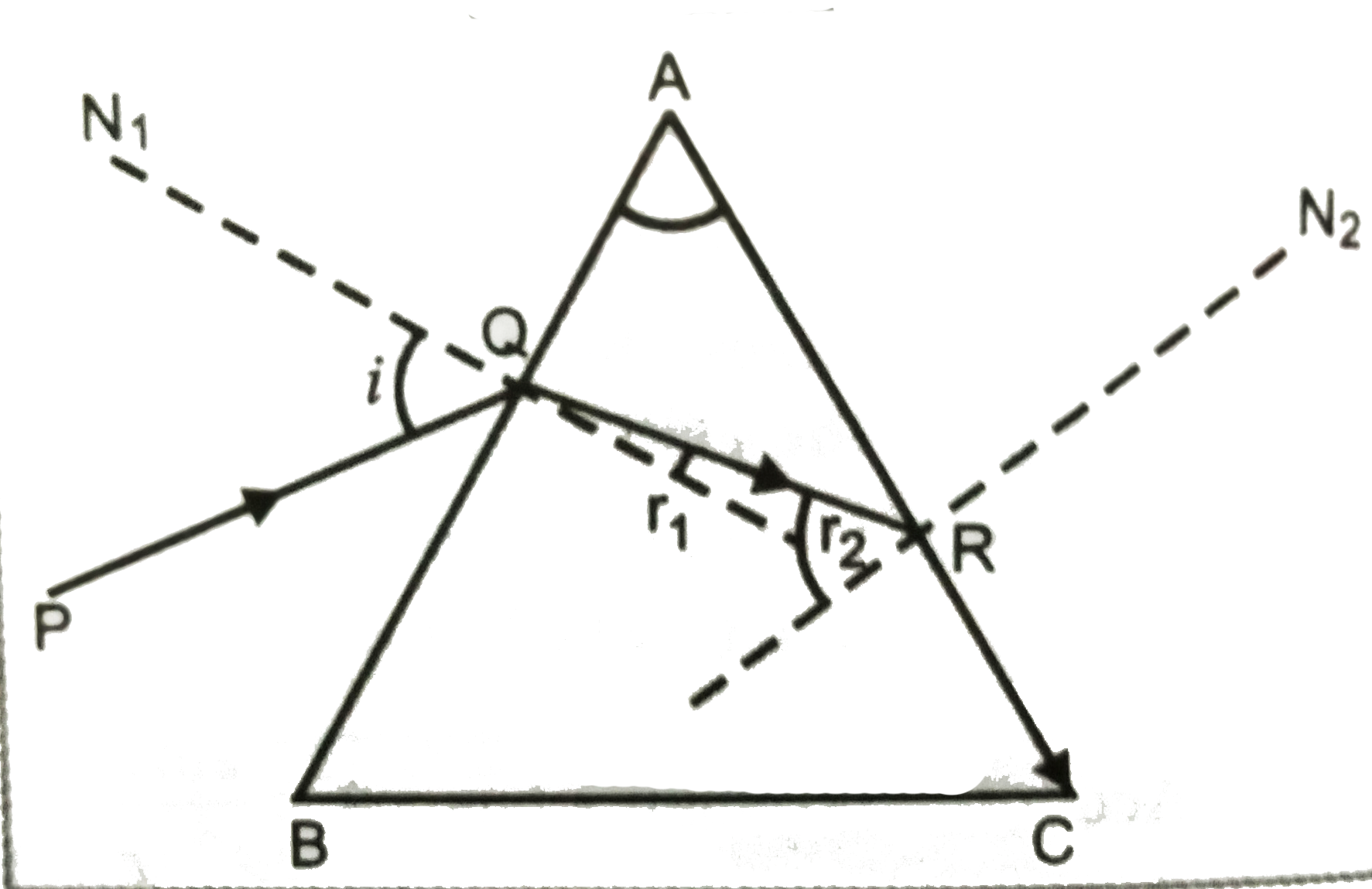A ray of light is incident on a glass prism of refractive index μ and refractive angle A. If it just suffers total internal reflection at the other face, obtain an expression relating the angle of incidence , angle of prism and critical angle.
To solve the problem of finding the relationship between the angle of incidence (I), the angle of the prism (A), and the critical angle (Ic) when a ray of light is incident on a glass prism and suffers total internal reflection, we can follow these steps:
1. Understand the Geometry of the Prism:
- Let the angle of the prism be A.
- A ray of light is incident on the first face of the prism at an angle of incidence I.
- The ray refracts into the prism and makes an angle R1 with the normal at the first surface.
2. Apply Snell's Law at the First Surface:
- According to Snell's law:
sinI=μsinR1
- Here, μ is the refractive index of the prism.
3. Determine the Angles Inside the Prism:
- The angle of refraction R2 at the second surface of the prism will be equal to the critical angle Ic when total internal reflection occurs.
- The relationship between the angles in the prism can be expressed as:
R1+R2=A
- Substituting R2=Ic:
R1+Ic=A⟹R1=A−Ic
4. Substitute R1 in Snell's Law:
- Substitute R1=A−Ic into the Snell's law equation:
sinI=μsin(A−Ic)
5. Apply Snell's Law at the Second Surface:
- For the second surface, where total internal reflection occurs:
μsinIc=sin90∘
- Since sin90∘=1:
μ=1sinIc
6. Substitute μ into the Equation:
- Now substituting μ back into the equation:
sinI=1sinIcsin(A−Ic)
7. Final Expression:
- Rearranging gives us:
sinI=sin(A−Ic)sinIc
- This can be expressed in terms of the inverse sine function:
I=sin−1(sin(A−Ic)sinIc)
Final Result:
The relationship between the angle of incidence I, the angle of the prism A, and the critical angle Ic is given by:
I=sin−1(sin(A−Ic)sinIc)
- Let the angle of the prism be A.
- A ray of light is incident on the first face of the prism at an angle of incidence I.
- The ray refracts into the prism and makes an angle R1 with the normal at the first surface.
- According to Snell's law:
sinI=μsinR1
- Here, μ is the refractive index of the prism.
- The angle of refraction R2 at the second surface of the prism will be equal to the critical angle Ic when total internal reflection occurs.
- The relationship between the angles in the prism can be expressed as:
R1+R2=A
- Substituting R2=Ic:
R1+Ic=A⟹R1=A−Ic
- Substitute R1=A−Ic into the Snell's law equation:
sinI=μsin(A−Ic)
- For the second surface, where total internal reflection occurs:
μsinIc=sin90∘
- Since sin90∘=1:
μ=1sinIc
- Now substituting μ back into the equation:
sinI=1sinIcsin(A−Ic)
- Rearranging gives us:
sinI=sin(A−Ic)sinIc
- This can be expressed in terms of the inverse sine function:
I=sin−1(sin(A−Ic)sinIc)
The relationship between the angle of incidence I, the angle of the prism A, and the critical angle Ic is given by:
I=sin−1(sin(A−Ic)sinIc)
Topper's Solved these Questions
- XII BOARDSBook:XII BOARDS PREVIOUS YEARChapter:XII BOARDSExercise:SECTION-C
Explore 55 Videos
- XII BOARDSBook:XII BOARDS PREVIOUS YEARChapter:XII BOARDSExercise:PHYSICS (Theory) DELHI BOARD -2016 [SET -I][COMPTT.]
Explore 12 Videos
- XII BOARDSBook:XII BOARDS PREVIOUS YEARChapter:XII BOARDSExercise:SECTION-A
Explore 31 Videos
- SAMPLE PAPER 2019Book:XII BOARDS PREVIOUS YEARChapter:SAMPLE PAPER 2019Exercise:SECTION D
Explore 6 Videos
Similar Questions
At what angle should a ray of light be incident on the face of a prism of refracting angle 60° so that it just suffers total internal reflection at the other face ? The refractive index of the material of the prism is 1.524.
View SolutionAt what angle should a ray of light be incident on the face of a prism of refracting angle 60∘, so that it just suffers total internal reflection at the other face ? The refractive index of the prism is 1.524.
View Solution
Knowledge Check
A ray of light is incident on a refracting face of glass prism of refracting angle 30∘. If the ray emerges normally from the second refracting surface, the angle of incidence is refracting surface, the angle of incidence is
[aμg=1.5]Asin−1(0.6)Bsin−1(0.7)Csin−1(0.75)Dsin−1(0.8)
At what angle should a ray of light be incident on the face of a prism of refracting angle 60∘ so that it just suffers total internal reflection at the other face ? The refractive index of the prism is 1.524.
View SolutionA ray of light is incident on the surface of a glass plate of refractive index 1.6 at polarzing angle. Calculate the angles of reflection and refraction.
View SolutionA ray of light incident normally on the first face of a glass prism of refractive index 1.6 just emerges from the other face. Find the angle of the prism.
View SolutionA ray of light is incident on a prism of refracting angle A. if θC is the critical angle for the material of the prism with respect to the surrounding air, then:
View SolutionA ray of light enters the face AB of a glass prism of refractive index μ at an angle of incidence i. Find the value of i such that no ray emerges from the face AC of the prism, given angle of prism is A.
View SolutionA ray of light the face AB of a glass prism of refractive index μ at an angle of incidence i. Find the value of i such that no ray emerges from the face AC of the prism. Given angle of prism is A.

View SolutionA ray of light falls on a glass plate of refractive index μ=1.5.
What is the angle of incidence of the ray if the angle between the reflected and
refracted rays is 90∘?
View Solution